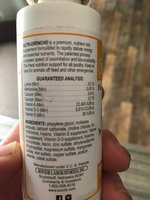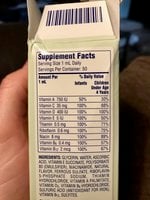I got some Poly-Vi-Sol today thinking that Nutridrench might not be enough on its own for an ill chicken of mine. I cracked it open to find EGADS, THIS STUFF LOOKS AND SMELLS EXACTLY THE SAME! Imagine spending $11 on something you already have but didn't. I feel pretty foolish right now. Am I mistaken, or is this essentially the same stuff? I don't want to overwork my tiny bird's kidneys giving her far more than she needs!
If you want the story:
I have a two month old serama pullet who I found lying on the bottom of her pen tonight, unable to stand. Her toes are curled and feet tucked beneath her. When I picked her up I was shocked to find she weighs hardly anything and is all bones. She has always been a quiet, sweet little thing but has never been a fan of being held, just petted. I feel a fool to have let her fall so far from good flesh before noticing there was a problem.. from now on, I'm going to start weighing everyone weekly. She hid her illness well from me. She gorged on food and water (you'd think I wasn't feeding her!) and I gave her nutridrench and water through a syringe first suspecting she might not want to eat. It has been half a day since she received her Nutridrench, and I have found she can now uncurl her toes when picked up, something I couldn't even force her to do when I first picked her up and was checking for bumblefoot. She is quarantined, and is surprisingly not too uncomfortable, as she talks happily for attention same as always, even purrs and grinds her beak just because she's getting talked to. I think she might be enjoying the extra attention. Here's hoping she doesn't learn to pretend to be sick!
I know a lot of people are going to cry MAREK'S!!!! but I firmly believe this is a riboflavin/vitamin B2 deficiency. I'll be seeing a vet to confirm, but for now I'm treating it as such. This coincides with a switch in feed I recently made to Texas Naturals, because it was a local, soy free feed and I'd been erroneously led to believe it was corn free too. The first bag seemed pretty great at first! The second bag, not so much. Their ingredients change frequently from what I understand depending on whatever's cheapest. I'm already in the process of switching to fermented Scratch and Peck feed and just dished out everyone's first serving tonight, knowing that this feed wasn't as right for my chickens as I thought it was when I first got the stuff. I'm also working toward stretching the feed further with BSF grubs and fresh barley fodder, so I'm already working to improve nutrition. I think this was a case of too little too late. I've put vitamins in the water of all the birds I fed on Texas Naturals just in case.
If you want the story:
I have a two month old serama pullet who I found lying on the bottom of her pen tonight, unable to stand. Her toes are curled and feet tucked beneath her. When I picked her up I was shocked to find she weighs hardly anything and is all bones. She has always been a quiet, sweet little thing but has never been a fan of being held, just petted. I feel a fool to have let her fall so far from good flesh before noticing there was a problem.. from now on, I'm going to start weighing everyone weekly. She hid her illness well from me. She gorged on food and water (you'd think I wasn't feeding her!) and I gave her nutridrench and water through a syringe first suspecting she might not want to eat. It has been half a day since she received her Nutridrench, and I have found she can now uncurl her toes when picked up, something I couldn't even force her to do when I first picked her up and was checking for bumblefoot. She is quarantined, and is surprisingly not too uncomfortable, as she talks happily for attention same as always, even purrs and grinds her beak just because she's getting talked to. I think she might be enjoying the extra attention. Here's hoping she doesn't learn to pretend to be sick!
I know a lot of people are going to cry MAREK'S!!!! but I firmly believe this is a riboflavin/vitamin B2 deficiency. I'll be seeing a vet to confirm, but for now I'm treating it as such. This coincides with a switch in feed I recently made to Texas Naturals, because it was a local, soy free feed and I'd been erroneously led to believe it was corn free too. The first bag seemed pretty great at first! The second bag, not so much. Their ingredients change frequently from what I understand depending on whatever's cheapest. I'm already in the process of switching to fermented Scratch and Peck feed and just dished out everyone's first serving tonight, knowing that this feed wasn't as right for my chickens as I thought it was when I first got the stuff. I'm also working toward stretching the feed further with BSF grubs and fresh barley fodder, so I'm already working to improve nutrition. I think this was a case of too little too late. I've put vitamins in the water of all the birds I fed on Texas Naturals just in case.





